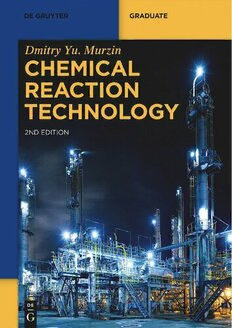
Chemical Reaction Technology PDF
Preview Chemical Reaction Technology
DmitryYu.Murzin ChemicalReactionTechnology Also of interest EngineeringCatalysis Murzin, ISBN----,e-ISBN---- ProcessIntensification. BreakthroughinDesign,IndustrialInnovationPractices, andEducation Harmsen,Verkerk, ISBN----,e-ISBN---- ChemicalProductTechnology Murzin, ISBN----,e-ISBN---- ProductandProcessDesign. DrivingInnovation Harmsen,deHaan,Swinkels ISBN----,e-ISBN---- ChemicalEnergyStorage Schlögl(Ed.), ISBN----,e-ISBN---- Dmitry Yu. Murzin Chemical Reaction Technology 2nd Edition Author Prof.DmitryYu.Murzin ÅboAkademiUniversity ProcessChemistryCentre Biskopsgatan8 20500Turku/Åbo Finland [email protected] ISBN978-3-11-071252-0 e-ISBN(PDF)978-3-11-071255-1 e-ISBN(EPUB)978-3-11-071260-5 LibraryofCongressControlNumber:2021951603 BibliographicinformationpublishedbytheDeutscheNationalbibliothek TheDeutscheNationalbibliothekliststhispublicationintheDeutscheNationalbibliografie; detailedbibliographicdataareavailableontheInternetathttp://dnb.dnb.de. ©2022WalterdeGruyterGmbH,Berlin/Boston Coverimage:zorazhuang/E+/GettyImages Typesetting:IntegraSoftwareServicesPvt.Ltd. Printingandbinding:CPIbooksGmbH,Leck www.degruyter.com Preface to the first edition There are quite a number of books available on themarket dealingwith industrial chemistry,oilrefining,andproductionofpetrochemicalsandorganicandinorganic chemicals.Manyofthemareofaverydescriptivenaturenotinvolvinganydiscussion offlowschemes. There is a wealth of textbooks covering various aspects of unit operations, in particular chemical reactors. There are few handbooks, encyclopedia, and text- booksonchemicaltechnologyalreadyavailable,includingveryrecenttextbooksof excellent quality by Moulijn, Makkee, and van Diepen entitled Chemical Process Technology, Jess and Wasserschied on chemical technology, and Bartolomew and Farrautoonindustrialcatalyticprocesses. The aim of the textbook is not to replace these and other excellent literature sources focusingmoreonthe chemistry of different reactions orchemicalengineer- ingtextbooksaddressingvariousissuesofreactorsandunitoperations,butratherto provide a helicopterviewon chemicalreaction technology, omittingspecificdetails alreadyavailableinthespecializedliterature.Moreover,theauthorfeelsthatthereis a niche for such a textbook since the majority of the textbooks aredealing with oil refiningandbasicinorganicand,toaverylimitedextent,organicchemicalsbutnot featuringthebreadthofindustrialorganictransformations. Forachemistandevenforachemicalengineerwhowouldliketobeintroduced tothefieldofchemicaltechnology,itwouldbemorenaturalandmethodologically- stimulating to see how various typesof chemicaltransformations are -implemented inthe industry,rather thantoreadabout apparently unconnected production tech- nologiesofdifferentchemicals. The textbook is based in part on a course on chemical reaction technology, whichtheauthorhasbeenteachingtochemistsandchemicalengineersforalmost 15 years, first covering the basics of chemical technology and also providing an overview of modern chemical and petrochemical industry. It then goes in depth intodifferentchemicalreactions,suchasoxidation,hydrogenation,isomerization, esterification, etc., following the style of chemistry textbooks rather than product- oriented technical literature. Owing to a large number of products in the chemical industry, exceeding tens of thousands, such an approach with the focus on reac- tions,certainlynotbeinganewone,willhopefullyfacilitateunderstandingofbasic principles of chemical reaction technology and their implementation rather than forcethestudentstomemorizehowcertainchemicalsareproduced. Variability of process technologies which can be applied industrially for the samereactionisanotherkeyfeaturethatwasspecificallyaddressedinthetextbook. The authorhimself, while studying at MendeleevUniversity of ChemicalTech- nology,tookacourseonchemicaltechnologyofbasicorganicchemicalsbasedon a reaction-oriented approach and found it very stimulating and actually useful in thesubsequentprofessionallife. https://doi.org/10.1515/9783110712551-202 VI Prefacetothefirstedition Workingasatraineeinachemicalplant,thenasaresearcherinagovernmen- talresearchcenterandlaterintheindustry,andcurrentlyinacademia,theauthor has met in the last 30 years many brilliant chemists and chemical engineers who have developed new technologies that were implemented industrially and/or im- provedtheexistingones.Someoftheirnamesappearedintherelevantpatents,but a majority are seldom known outside of their respective companies. This book is dedicatedtothem. DmitryMurzin May2015,Turku/Åbo Preface to the second edition Thefirstadditionofthebookapparentlywasabletofinditsreaders,whichprompted the publisherand then the authorto consider a possibility of preparing the second edition. TheauthorisgratefultotheeditorialteamatDeGruyterforefficientcollabora- tioninmakingthiseditionpossible. The original text was revised and expanded, updating the processes already covered in the first edition and introducing some other reactions not touched ini- tially. Moreover, the chapter on chemical processes and unit operations has been significantlyenlarged.Theauthorwaskeepingstillthefocusonchemicalreaction technology,asitwasnotanintentiontoreplacewiththecurrentworktextbookson chemicalreactionengineering,chemicalreactors,ordesignofchemicalprocesses. For the first edition,a substantial contribution to drawing of a large number of figureswasdonebyMSc(Chem.Eng.)ElenaMurzina,whopassedawayin2019after alonganddifficultbattlewithanoncologicaldecease. Thistextbookisdedicatedtohermemory. DmitryMurzin November2021,Turku/Åbo https://doi.org/10.1515/9783110712551-203 Contents Prefacetothefirstedition V Prefacetothesecondedition VII Abouttheauthor XV Chapter1 Chemicaltechnologyasscience 1 1.1 Basicprinciples 1 1.1.1 Continuousorbatch? 2 1.1.2 Multilevelchemicalprocessing 5 1.1.3 Largeorsmallchemicalplants? 8 1.2 Alternativeproductionroutes 10 1.3 Evaluationofchemicalprocesses 12 1.4 Chemicalprocessdesign 13 1.4.1 Economicaspects 13 1.4.2 Flowschemes 17 1.4.3 Sustainableandsafechemicaltechnology:process intensification 23 1.4.4 Wastemanagement 40 1.4.5 Conceptualprocessdesign 46 1.4.6 Processcontrol(compiledtogetherwithDr.EugeneMourzine, UniversityofAkron) 55 1.4.7 Productdesign 59 1.4.8 Patents 66 Chapter2 Physico-chemicalfoundationsofchemicalprocesses 69 2.1 Stoichiometry 69 2.2 Thermodynamics 72 2.3 Catalysis 76 2.4 Kinetics 85 2.5 Masstransfer 88 Chapter3 Chemicalprocessesandunitoperations 95 3.1 Overviewofunitoperations 95 3.2 Mechanicalandhydromechanicalprocesses 96 3.2.1 Sedimentation 96 3.2.2 Filtration 100 X Contents 3.2.3 Mixingofemulsions 104 3.2.4 Sizereduction 104 3.2.5 Sizeenlargement 105 3.2.5.1 Tableting 107 3.2.5.2 Extrusion 109 3.3 Masstransferprocesses 112 3.3.1 Distillation 112 3.3.2 Extraction 122 3.3.3 Adsorption 125 3.3.4 Absorption 129 3.3.5 Crystallizationandprecipitation 137 3.3.6 Leaching 147 3.4 Chemicalreactors 148 3.4.1 Homogeneousprocesses 149 3.4.2 Non-catalyticheterogeneousprocesses 151 3.4.3 Catalyticreactors 159 3.4.3.1 Two-phasereactors 160 3.4.3.2 Three-phasecatalyticreactors 166 Chapter4 Chemicalprocessindustry 172 4.1 Generaloverview 172 4.2 Feedstockforchemicalprocessindustries 177 4.3 Oilrefining 186 4.4 Naturalgasprocessing 196 4.5 Processingofcoal 196 4.6 Biomassprocessing 201 Chapter5 Hydrogenandsyngasgeneration 218 5.1 Steamreformingofnaturalgas 218 5.2 Gasification 236 5.3 Water-gasshiftreaction 241 Chapter6 Cracking 244 6.1 General 244 6.2 Visbreaking 244 6.3 Hydrocracking 248 6.4 Fluidcatalyticcracking 265 6.5 Steamcracking 284
